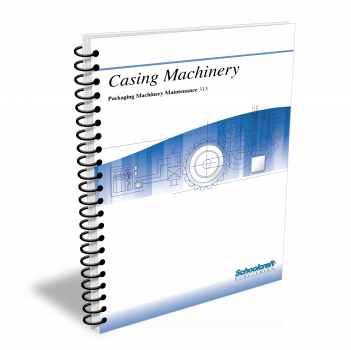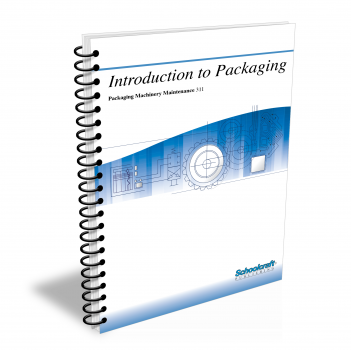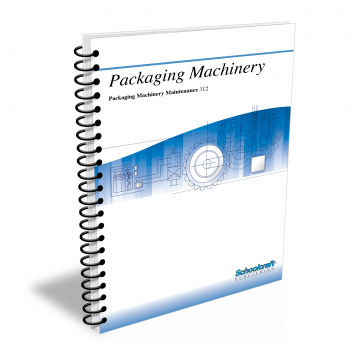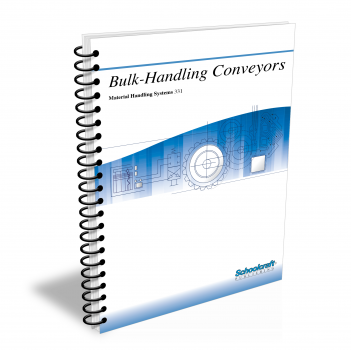Casing Machinery

Course Number: 313
The Casing Machinery textbook covers operating characteristics and service techniques of accessory or auxiliary machines used with packaging lines. It describes general operating characteristics of labeling equipment, uncasing, unscrambling, and cleaning machines, gluing equipment and adhesives, wrapping machines, tying, strapping, and stitching machines, and shrink wrapping devices.
Does your curriculum require additional topics not included in this textbook? Build a customized version of the Casing Machinery textbook below.
Recommended Contact Hours – 20
Preview a Chapter
Available Supporting Material
- Table of Contents
- Exam Copies
- Suggested Titles
Table of Contents
Chapter 1: Uncasing and Unscrambling
Topics: Manual uncasing; Low-volume uncasing and unscrambling; Unscrambling with conveyors; Automatic uncasing; Conveyor chain and care
Learning Objectives:
- List the steps that must occur before an empty container can be processed.
- Tell which types of conveyors are typically used for unscrambling.
- Explain how the pickup head of an automatic uncaser grips different container shapes.
- List important steps in the periodic care and maintenance of roller chain.
Chapter 2: Cleaning and Washing
Topics: Air cleaning; Manual washing with water; Bottle washer/rinser; Metal washers; Container warming; Pasteurization; Maintenance
Learning Objectives:
- Name the two methods by which containers are usually cleaned.
- Describe the automatic air cleaning operation.
- Describe the operation of an automatic bottle washer and rinser.
- Describe the operation of a high-production bottle washer.
- Explain why pasteurization is important.
Chapter 3: Gathering Machines
Topics: Multi-packing machines; Skip-carton detector; Continuous-run accumulator; Stacking sequence; Cycling operations; Case packing, bundling machines; Maintenance
Learning Objectives:
- Name the three types of gathering machines currently in use.
- Describe the operation of a bundling machine.
- Describe the infeed supply operation and cycle of a multipacker.
- Name the two functions of a typical case packer.
- Explain your most important responsibility in gathering machine maintenance.
Chapter 4: Cartoning Machines
Topics: Carton making; Types of cartons and machines; Glue-end cartons; Carton feeding; Product infeed; Machine attachments; Closing and gluing
Learning Objectives:
- Define the following terms: reverse tuck, arthur lock, and crash fold.
- Explain why butt flaps are rarely used.
- Describe the operation of cartoning machines and related carton feeding methods.
- Explain how cartons are typically closed and glued.
- List steps involved in cartoning machine maintenance.
Chapter 5: Casing Machines
Topics: Horizontal and vertical machines; Top, side, and bottom filling machines; Case taping machines; Heatshrink sealing; Maintenance
Learning Objectives:
- Tell how the manner in which cases are filled is determined.
- Explain the function of a compression unit.
- Contrast top filling and side filling machines.
- Explain the purpose and operation of electrical interlocks in an automatic casing machine.
- Identify the source of heat control problems in a shrink film machine.
Chapter 6: Wrapping Machines
Topics: Wrapping materials; Settings and controls; Paper feed; Paper corrugating wires, rollers, cutoff change gears, knife, feed belt, stops, and guides
Learning Objectives:
- Explain the function of registration dots on the continuous roll paper used on wrapping machines.
- Explain the functions of the paper corrugating wires in a wrapping machine.
- Trace the operation of a typical wrapping machine, including timing elements.
- Tell how to clear a jam in a wrapping machine.
- Describe various kinds of glue used in wrapping machines and their application.
Chapter 7: Strapping and Stitching
Topics: Strapping materials; Tensioners; Sealers; Combination tools; Strapping systems; Stitching machines; Stitch defects; Adjustments
Learning Objectives:
- Explain why a tensioner and sealer are sometimes combined into a single assembly.
- Describe the maintenance required by strapping heads.
- Explain the operation of a stitching machine.
- List common stitching machine problems and stitch defects and tell their probably causes.
Chapter 8: Adhesives and their Application
Topics: Properties and types of adhesives; Hot melts; Application systems; Troubleshooting, maintaining, and cleaning equipment
Learning Objectives:
- Define the terms penetration, tackiness, and viscosity as they relate to adhesives.
- Name the most likely source of trouble in hot melt application machinery
- List steps involved in servicing a hot melt dispensing head.
- Explain common maintenance items related to application equipment.
- Describe the storing and handling requirements for liquid adhesives.
Chapter 9: Labeling and Coding
Topics: Label forms; Continuous roll, indirect label feeding; Pressure-sensitive labeling, heads; Coding attachments; Flexographic imprinting
Learning Objectives:
- Name common problems in labeling operations and give their solutions.
- Describe the process of continuous roll feeding.
- Explain the periodic maintenance required of labeling heads.
- Explain the operation of a friction-driven coder and a flexographic imprinter.
Chapter 10: Maintenance and Safety
Topics: Planned maintenance; Spare parts; Lube schedules; Mechanical and electrical maintenance; Fluid components maintenance; Guards
Learning Objectives:
- Identify the key to good planned maintenance.
- Name the two most important factors in drive belt wear on a packaging machine.
- List items to consider when replacing a motor?
- Explain the purpose of recommended color codes for plant equipment.
- Name the leading causes of industrial injuries.
Request Exam Copies
Exam Copies
Ready to see a copy of our textbooks? After selecting which textbooks you’d like to review for your course, you can submit your request by either logging in or creating an account so we know where to ship your exam copies. A representative from Schoolcraft will contact you to confirm and finish processing your request.
Exam copies are always free and yours to keep.
Selected Exam Copies
none selected
* Maximum of five copies can be ordered


